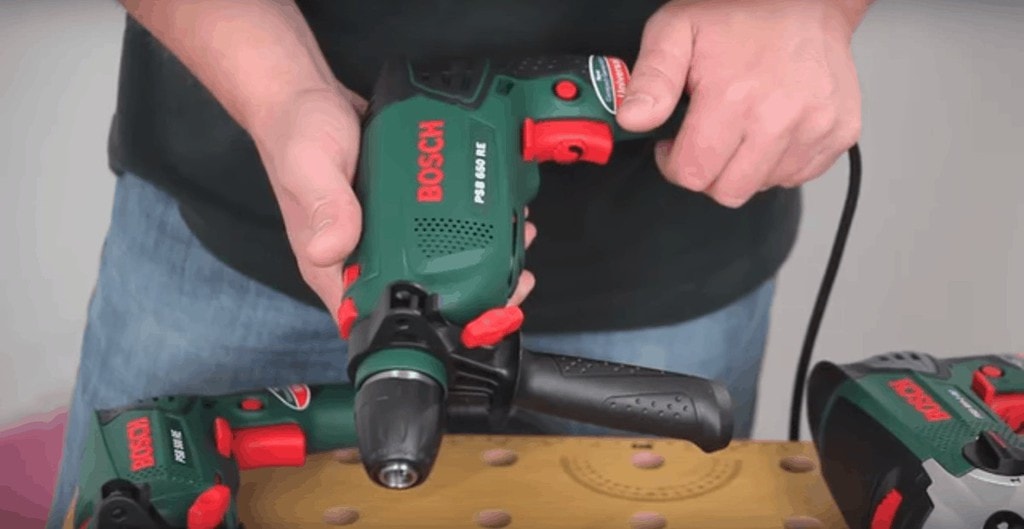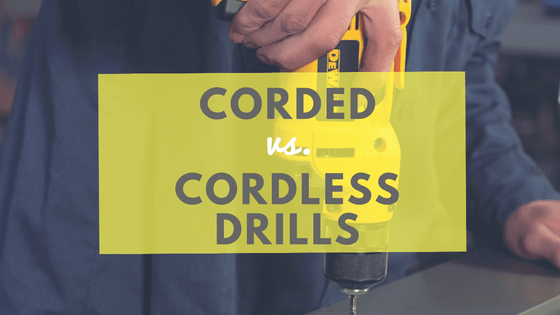
So what’s the difference between that noisy corded drill out in your garage and the sleek, new, cordless one sitting next to it on the workbench?
The obvious difference is mobility; pop the battery in your cordless drill, and you’re free to roam until your heart’s desire (or until your battery power runs out of juice). Your corded drill, on the other hand, is of course reliant upon that cumbersome extension cord that most DIY’ers have a love/hate relationship with.
Quick Summary: Top Rated Drills
However, there’s a bit more to it than that.
In this article, we’ll take a thorough look at the differences between corded and cordless drills; RPM’s, max power output, and the advantages/disadvantages of each.
So, whether you’re just curious about why you have one of each electric drill sitting out in your garage, or you’re trying to make a decision on which kind to buy, hopefully we can be of some sort of assistance and lay to rest some of those burning questions you might have. Keep reading to find corded vs cordless drill.
Power: It’s all about TORQUE
Before we get into any sort of number crunching or head-to-head comparisons, we’ll go ahead and say that generally speaking, a corded drill is more powerful than cordless power tool; they have a never-ending 110-volt supply of electricity to run off of, while cordless drills are at the mercy of 12, 18, or maybe 20-volts at the most. Don’t forget to check out the new kid on the block: Best Brushless Drills, our full review.

Now, without getting off on too much of a tangent (and having to break out our old electrical engineering notes from college), let’s take a look at some max power outputs of some corded and cordless drills, and maybe clear up a few misconceptions about volts, watts, amps, power, and torque along the way.
Corded drills, like we said of course run off the standard 110-volt power supply from your home or garage – their max power output is dependent upon the size of electric motor they have, which is measured in amps. For example, a corded power drill with a 7-amp motor will have a maximum power output of 770 watts (watts = volts x amps).
However, watts (max power output) isn’t necessarily the best unit to consider when comparing drills. What we’re more interested in is speed and torque: Speed (measured in RPM) is simply how fast the drill spins, and torque (measured in inch-pounds) is how much rotational umph is behind the spinning.
Make sense?
A lot of today’s top-quality cordless drills can get some seriously impressive torque and speed out of their 18 or 20-volt batteries, and will provide you with all the power you could ever need for around-the-house use.
DeWalt has actually been using an interesting calculation called max watts out (MWO) to designate a max power value for their cordless drills. This 20-volt drill, for example, has a MWO of 300; obviously a good deal less powerful than our previous example of the 7-amp corded power tool that had a max power of 710-watts.
However, like we said, the real proof of the pudding is in the form of torque and speed, which corded drills are able to pack more of given their larger power supply.
Other things to consider in the cord debate
So we’ve established that, in general, a corded tool is more powerful than a cordless one. What are some other things to consider between the two?
Size, weight, and handling
Because they don’t have to account for those bulky, heavy batteries, corded drills are typically a good deal leaner, lighter, and smaller than cordless drills. For this reason, most professionals always bring a corded drill along with them to jobsites, in case they need to get into a tight spot where their bulky cordless drill(s) can’t fit.
Convenience and mobility
Not being limited or hindered by a power cord is obviously the massive benefit of cordless drills over corded. There’s nothing more convenient than popping in a battery pack and getting on with a job. However, on the flip side of things you’re then limited time-wise by the charge of the battery – it’s all give and take.
Lifespan
This is something to think about. Most people will say that the worst thing for a battery is to let it sit for long periods of time without being used. If you’re in the market for a drill but don’t anticipate actually using it a lot, you may want to consider going corded. Even with frequent use, of course, batteries don’t last forever – you can expect a good several years out of them, but not the decades that you’ll get with a corded drill.
Multiple uses for battery
Another huge benefit of today’s cordless tools is that you can use the same battery for your drill, circular saw, impact driver, etc; if you’re just starting out setting up a garage and plan on getting a few essentials, a cordless tool is certainly an economic way to go.
Most manufacturers actually make great combo kits (like this one from DeWalt) that set you right up with a couple batteries, a charger, and few of the most important power tools that you’ll need.
Our Top Picks: Best Drills Overall
So what’s the bottom line – do you go cordless or corded?
Well, that’s a decision you’ll have to make based on your specific needs, applications, etc.
Personally, we prefer to have both around – it’s nice to be able to grab the trusty old corded drill when you need it, and there’s certainly no replacing the convenience of a quality cordless drill.
Whichever one you choose, here’s a list of a few of our favorite models out there for both corded and cordless:
Corded Drills
DEWALT DW223G 7 Amp 3/8-Inch Drill
This is a super-value, workhorse of a cordless drill that will supply you with plenty of power for all your ‘round-the-house needs with its 8-amp, 2,500 max rpm motor. Also, it’s got a variable speed trigger so you can conveniently work with a range of materials and different size drill bit – an excellent all-arounder.
Ryobi D48CK 5.5-amp ⅜” Variable Speed Corded Drill
Our value pick. If you’re looking for the best inexpensive option out there, this could be the one. With a variable speed 5.5 amp motor, it suits just fine for all the standard, run-of-the mill jobs that you’ll put it to use on around the house.
Cordless Drills
DeWalt DCD771C2 20-Volt MAX ½” Cordless Drill/Driver
Like we’ve said time and again, in our opinion it’s hard to beat DeWalt’s line of 20-volt MAX cordless tools; great charge times, long battery life, and plenty of power. This one boasts a 2-speed motor (0-450 and 1,500 rpm) and has a max power output of 300 MWO.
Milwaukee 2606-22CT M18 ½” Cordless Drill/Driver
Goes tit-for-tat with the DeWalt – the M18 REDLITHIUM batteries that Milwaukee’s come out with are really the best we’ve seen in the industry, rivaled only of course by DeWalt’s 20-volt MAX.
Bottom Line
To break down an entire article into a couple sentences:
Corded drills are generally more powerful, leaner, and lighter than their cordless cousins. However, they’re noisier, less convenient, and your mobility is restricted.
Cordless power drills on the other hand are irreplaceably convenient, yet are bulky and heavy in comparison to corded tools with a limited lifespan and obvious power restrictions.
Did you enjoy this article? Check out some more articles I have written:
- Makita vs DeWalt – Who Makes A Better Set of Power Tools?
- Hammer Drill vs. Regular Drill: Do You Need Both Types of Drills?
- Leatherman vs. Swiss Army Knife: Which is the Best Multi-Tool?
- Milwaukee vs Ridgid – Tool Brand Showdown & Comparison
- Sabre Saw vs. Jigsaw – Is There Any Difference In These Tools?
- Trim Saw vs. Circular Saw – What’s The Real Difference?
- Jawhorse vs. Workmate: Which Portable Workbench is Better?
- Corded vs. Cordless Drill – Which One Will Suit You Best?
- Hammer Drill vs. Impact Driver – What’s the Difference & Do I Need Both?
- What is a Hammer Drill and Which One is Best?
- Milwaukee vs. DeWalt – Which Tool Brand Is Better?
- The Complete DIY Tool List – 15 Essentials For People Who Make Stuff


You can always trust a good corded drill not to run out of charge. That is one of its main advantages. Time saving. To charge a cordless drill can take a while